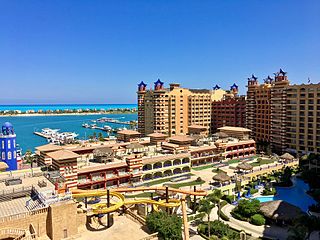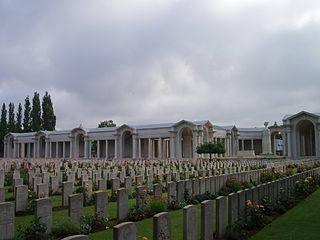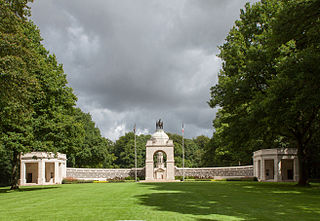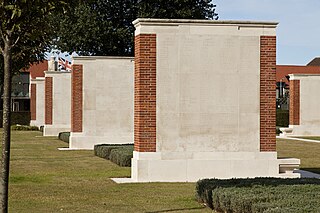
El Alamein is a town in the northern Matrouh Governorate of Egypt. Located on the Mediterranean Sea, it lies 106 kilometres (66 mi) west of Alexandria and 300 kilometres (186 mi) northwest of Cairo. The town is located on the site of the ancient city Antiphrai which was built by the Romans.(Greek: Ἀντίφραι).

The Commonwealth War Graves Commission (CWGC) is an intergovernmental organisation of six independent member states whose principal function is to mark, record and maintain the graves and places of commemoration of Commonwealth of Nations military service members who died in the two World Wars. The commission is also responsible for commemorating Commonwealth civilians who died as a result of enemy action during the Second World War. The commission was founded by Sir Fabian Ware and constituted through royal charter in 1917 as the Imperial War Graves Commission. The change to the present name took place in 1960.

Desert warfare is warfare in deserts or similar arid or semi-arid environments. The term encompasses military operations affected by the terrain, climate, and resource availability of these areas, as well as the strategies and tactics used by military forces in these situations and environments.

The Syria–Lebanon campaign, also known as Operation Exporter, was the invasion of Syria and Lebanon in June and July 1941 by British Empire forces, during the Second World War.

The Kranji War Cemetery is located in Kranji, Singapore, and is the final resting place for Allied soldiers who perished during the Battle of Singapore and the subsequent Japanese occupation of the island from 1942 to 1945 and in other parts of Southeast Asia during World War II.

Cambridge American Cemetery and Memorial is a World War II American military war grave cemetery, lying between the villages of Coton and Madingley, 7 km (4.3 mi) north-west of Cambridge, England. The cemetery, dedicated in 1956, contains 3,811 American war dead and covers 30.5 acres (12.3 ha). It is one of 26 overseas military cemeteries administered by the American Battle Monuments Commission (ABMC).

The Port Tewfik Memorial was originally situated at Port Tewfik, now called Suez Port, on the Suez Canal. It was unveiled in May 1926 for the Imperial War Graves Commission and commemorated 4,000 officers and men of the Indian Army killed during the Sinai and Palestine Campaign during the First World War. The original memorial was designed by Scottish architects John James Burnet and Thomas S. Tait, and included sculptures by British sculptor Charles Sargeant Jagger.
Tell El Kebir is 110 km north-north-east of Cairo and 75 kilometres south of Port Said on the edge of the Egyptian desert at the altitude of 29 m. Administratively, it is a part of the Ismailia Governorate.

The Bayeux War Cemetery is the largest Second World War cemetery of Commonwealth soldiers in France, located in Bayeux, Normandy. The cemetery contains 4,648 burials, mostly from the Invasion of Normandy. Opposite this cemetery stands the Bayeux Memorial which commemorates more than 1,800 casualties of the Commonwealth forces who died in Normandy and have no known grave.
Sir John Hubert Worthington was an English architect.

The Arras Memorial is a World War I memorial in France, located in the Faubourg d'Amiens British Cemetery, in the western part of the town of Arras. The memorial commemorates 35,942 soldiers of the forces of the United Kingdom, South Africa and New Zealand, with no known grave, who died in the Arras sector between the spring of 1916 and 7 August 1918.

The Delville Wood South African National Memorial is a World War I memorial, located in Delville Wood, near the commune of Longueval, in the Somme department of France. It is opposite the Delville Wood Commonwealth War Graves Commission Cemetery, on the other side of the Longueval–Ginchy road.

The Arras Flying Services Memorial Commonwealth War Graves Commission war memorial in the Faubourg d'Amiens Cemetery, Arras, France. The memorial commemorates nearly 1,000 airmen from forces of the Commonwealth who were killed on the Western Front during World War I and who have no known grave. The memorial was designed by Edwin Lutyens, sculpted by William Reid Dick and unveiled by Hugh Trenchard, 1st Viscount Trenchard, Marshal of the Royal Air Force on 31 July 1932.

The Helles Memorial is a Commonwealth War Graves Commission war memorial near Sedd el Bahr, in Turkey, on the headland at the tip of the Gallipoli peninsula overlooking the Dardanelles. It includes an obelisk which is over 30 metres (98 ft) high.

The Basra Memorial is a Commonwealth War Graves Commission war memorial near Zubayr, Iraq. The memorial commemorates 40,682 Commonwealth forces members who died during the Mesopotamian Campaign, from the Autumn of 1914 to the end of August 1921, and whose graves are not known. The memorial was designed by Edward Prioleau Warren. It was unveiled by Gilbert Clayton on 27 March 1929. Originally located eight kilometres north of Basra, near the Shatt al-Arab River, it was moved southwest in 1997 to a battleground from the much more recent Gulf War.
Heliopolis War Cemetery, which includes two relocated memorials - the Heliopolis Memorial and the Heliopolis (Aden) Memorial, is a war cemetery & memorial in the Heliopolis district of Cairo in Egypt for Commonwealth personnel of British Indian Army who died in World War I (WWI) and World War II (WWII). Of the 4,000 personals buried or commemorated here, 3727 are Indians - of whom nearly 2000 died in WWI and 1700 died in WWII.
John Frederick Price was an Australian rules footballer who played with Hawthorn in the Victorian Football League (VFL).

The Dunkirk Memorial is a Commonwealth War Graves Commission memorial to the missing that commemorates 4,505 missing dead of the British Expeditionary Force (BEF), most of whom fell prior to and during the Battle of Dunkirk in 1939 and 1940, in the fall of France during the Second World War.

The Doiran Memorial is a Commonwealth War Graves Commission war memorial that is both a battlefield memorial and a memorial to the missing. It honours the dead of the British Salonika Force as well as commemorating by name the 2171 missing dead of that force who fell in fighting on the Macedonian front during the First World War in the period 1915–1918.

Adelaide River War Cemetery is a heritage-listed cemetery at 105 Memorial Terrace, Adelaide River, Northern Territory, Australia. It was added to the Australian Commonwealth Heritage List on 22 June 2004.
















